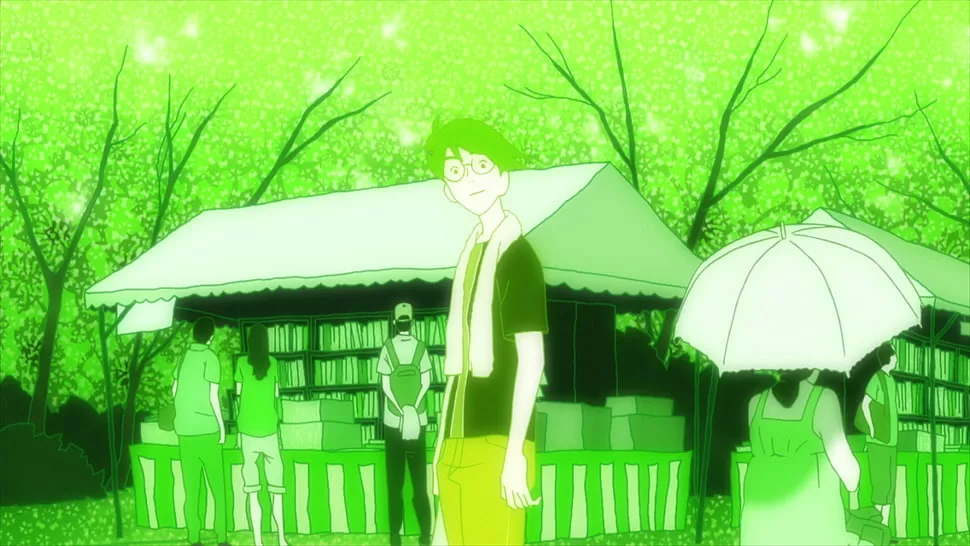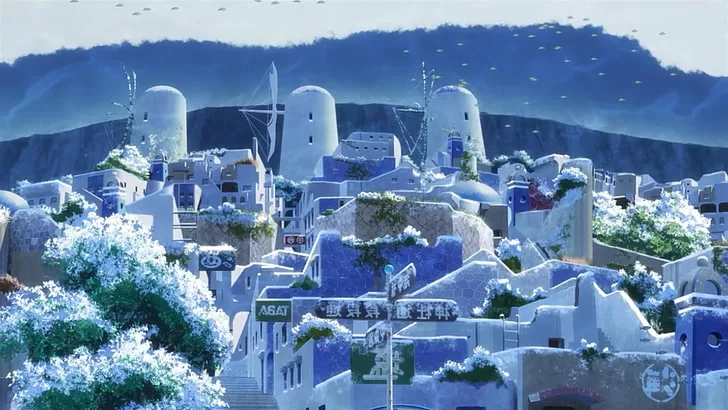09 Feb Anime Architecture: Fantastical Dreams Meet Artistic Realities
Anime architecture, a form of entertainment, draws inspiration from various sources, including historical, cultural, and futuristic elements. In historical or fantasy settings, anime often incorporates traditional Japanese architecture, such as shrines, temples, castles, and houses. Futuristic and technological visions are explored in cyberpunk aesthetics, with towering skyscrapers, neon lights, and advanced technology. Science fiction influences play a role in anime, with advanced civilisations depicted with futuristic architecture. Anime architecture blends traditional and modern styles, reflecting the cultural diversity and impacts that have shaped modern Japan and the global architectural discourse. This creative expression and push for boundaries in architecture can inspire architects to think outside conventional boundaries.
Imaginative World of Animation

Anime often features fantastical worlds with imaginative architecture, ranging from futuristic cities to magical realms. At the same time, some realistic anime accurately depict existing architectural styles, including urban landscapes and traditional Japanese buildings. Anime-inspired architecture draws inspiration from pop culture, featuring futuristic and technological elements. Architects often incorporate these elements into their designs, creating buildings that resemble science fiction or cyberpunk. Anime’s vibrant colour palettes and stylized shapes make them eye-catching and unconventional.
15 Anime Shows that portray architecture beautifully
1. Mushishi

“Mushishi” is an anime series that combines traditional Japanese settings with architectural elements, creating a serene atmosphere. The series features idyllic villages, ancient shrines, and rural landscapes, capturing the essence of different historical periods in Japan. The visuals are rich and immersive, showcasing the coexistence of humanity and nature in various settings. It’s a visually evocative and harmonious anime that appeals to fans of urban or fantastical architectural designs.
2. Spirited Away

“Spirited Away” features a magical and mysterious world, with a focus on architecture. The film’s central setting is a large, intricate bathhouse filled with unique elements, which takes the protagonist through fantastical landscapes, each with its own architectural elements. The spirit world, a realm filled with diverse spirits and creatures, is a blend of traditional Japanese architecture and a magical otherworldly twist. Studio Ghibli’s attention to detail in animation is evident in the film’s portrayal of architecture, enhancing the visual storytelling.
3. The Garden of Words

“The Garden of Words” is known for its realistic portrayal of Tokyo’s urban landscapes featuring detailed urban settings, seasonal changes, and a traditional-style pagoda in Shinjuku Gyoen National Garden. The film’s realism extends to the architecture, blending modern and traditional structures, creating an immersive experience that conveys the emotions and themes of the story through the architecture, which serves as a symbol of the city’s beauty.
4. Your Name

“Your Name” showcases Tokyo’s modern cityscape with skyscrapers and contemporary architecture while also showcasing rural areas with traditional homes and shrines. The film takes the characters to the fictional town of Itomori, incorporating cultural elements into its architectural designs. It uses symbolic structures, such as a comet-viewing platform, to convey emotional and thematic depth. The film explores the theme of changing seasons, showcasing the transformative beauty of nature and human-made structures.
5. Eden of the East

“Eden of the East” showcases diverse architectural settings, including urban centres, rural landscapes, and iconic Japanese structures. The contrast between urban and rural environments adds depth to the narrative, reflecting the characters’ journeys and mysteries. The series incorporates technology, incorporating high-tech facilities and structures, to create a futuristic and speculative atmosphere.
6. Ghost in the Shell: Stand Alone Complex

“Ghost in the Shell: Stand Alone Complex” is an anime series that focuses on architecture in its cyberpunk and futuristic settings, featuring sprawling, technologically advanced cities with towering skyscrapers, neon lights, and a blend of futuristic and industrial design elements. The series blurs the line between virtual and real worlds, blending virtual landscapes with physical structures and incorporating digital and augmented reality elements.
7. A Place Further than the Universe

“A Place Further than the Universe” focuses on the journey and personal growth of characters rather than architectural aesthetics. The story revolves around a group of girls travelling to Antarctica, with the characters’ emotional journey being the main focus. The beauty lies in the character development, emotional storytelling, and exploration of personal aspirations rather than detailed architectural depictions.
8. March Comes in Like a Lion

“March Comes in Like a Lion” follows the personal journey of professional shogi player Rei Kiriyama. The focus is on character relationships and personal struggles, with the architecture serving as a backdrop to enhance the overall storytelling experience. The series’s use of architecture adds authenticity to the characters’ experiences and provides a rich and immersive world that complements the emotional narrative.
9. Patema Inverted

“Patema Inverted” explores the contrast between the surface and inverted worlds, with buildings and structures appearing upside-down from the surface world’s perspective. The inverted world’s architecture adds a sense of wonder and otherworldliness to the narrative. The cinematography highlights the architectural elements, reinforcing the gravity-defying nature of the story.
10. The Tatami Galaxy

“The Tatami Galaxy” explores themes of choice, regret, and personal growth through a protagonist’s college life in parallel worlds. The protagonist experiences different versions of his college life in parallel worlds, revisiting certain spaces and symbols. The series uses creative cinematography, including unconventional camera angles and dynamic transitions, to highlight architectural elements. The unique approach to animation adds depth to the visual storytelling, allowing it to explore themes related to time and personal choices.
11. No. 6

“No. 6” features a futuristic cityscape with advanced technology and a well-planned urban environment, contrasting the luxurious lifestyle in the central region with the impoverished living conditions in the outer districts. The city is equipped with security structures, distinctive buildings, and a city layout that shapes its inhabitants’ lives. The series incorporates elements of nature, such as parks and green spaces, into its architectural design.
12. ACCA: 13-Territory Inspection Dept

“ACCA: 13-Territory Inspection Dept,” blends political intrigue with a unique visual style. The series is set in a fictional world with 13 districts, each with unique cultural and architectural characteristics. The architecture reflects the cultural diversity of the world, from urban centres to rural areas. The series pays attention to architectural details, showcasing the design of streets, buildings, and public spaces, establishing a sense of place for each district.
13. Tokyo Magnitude 8.0

“Tokyo Magnitude 8.0” portrays the aftermath of a devastating earthquake in Tokyo, focusing on the emotional and human aspects of survival and recovery. The series highlights the architectural aspects of these spaces, highlighting the challenges faced by survivors in finding safe and functional places to stay. Despite not focusing on conventionally beautiful architecture, “Tokyo Magnitude 8.0” effectively conveys the impact of a major natural disaster on a metropolitan area.
14. Nagi no Asukara

“Nagi no Asukara” surveys the lives of characters in both underwater and coastal settings. The series incorporates Japanese culture, such as shrines and temples. The integration of nature and visual appeal, along with the combination of underwater and coastal architecture, along with cultural landmarks, add depth to the story. The series’ focus on characters, relationships, and fantasy elements further enhances the atmosphere.
15. Violet Evergarden

“Violet Evergarden” showcases beautifully rendered architectural elements, drawing inspiration from European architecture, postal service buildings, manor houses, and urban environments. Symbolic locations, such as the Evergarden residence, contribute to the emotional weight of the narrative. The high production quality and attention to detail are evident in the intricate designs and intricate designs of architectural elements.
Conclusion
Anime has significantly influenced modern culture, particularly in architecture. It offers inspiration for design elements, with imaginative designs ranging from futuristic cityscapes to traditional Japanese structures. Anime architecture explores futuristic concepts, particularly in science fiction and cyberpunk genres, which inspire architects and urban planners to think creatively about the future of architecture. As anime architecture gains international popularity, it serves as a medium for the exchange of cultural ideas, encouraging cross-cultural influences. The use of virtual worlds and augmented reality in anime can spark interest in augmented reality in architecture. Anime architecture offers insights into community spaces and urban planning, influencing discussions on social connectivity and community design.
Content Writing And Research By: Ar. Priyanshi Shah
The post Anime Architecture: Fantastical Dreams Meet Artistic Realities appeared first on The Architects Diary.




No Comments